Attractions · Going Out · Peru · Regions · South America
6 must-see Plazas in Peru
When you look at maps of Peruvian cities, youll notice every city includes a Plaza de Armas or a Plaza Mayor. For the Spanish, a citys Plaza de Armas was the center of administrative, military, and religious power. These plazas arent always the largest or most centrally located squares, as many of Perus cities have changed a great deal since the Spanish first colonized Peru. But in many cities they remain excellent showcases of some of the citys oldest and most elaborate architecture.
Major cities fill their Plazas de Armas with bright flowers and glossy palms. In every Plaza de Armas youll find a cathedral facing the plaza. These plazas remain important cultural centers, with museums, galleries, and restaurants in every direction.
1. Trujillo
Trujillo has one of the largest Plazas de Armas in all of Peru. When you arrive at Trujillos Plaza de Armas, you will find your eye drawn to the contrasting colors of two side-by-side buildings the sandy-yellow Trujillo Cathedral and the bright blue Trujillo Archdiocese. Inside the cathedral youre welcome to admire the religious art.
Trujillo gained its independence in 1820, and played an important role in the fight for Peruvian independence from Spain. To commemorate the citys independence, Trujillos government commissioned the Freedom Monument for the plazas centerpiece. It is composed of three statues, and each represents one of the stages of Trujillos liberation from Spanish oppression.
 On Sunday mornings, the city holds a flag-raising ceremony in the Plaza de Armas, occasionally accompanied by folk dancing. From Trujillos Plaza de Armas visitors can begin their tour of the old city, and walk to see the colonial architecture on nearby streets.
2. Arequipa
Spanish conquistadors founded Arequipa in 1540. The Spanish built this city with white, volcanic sillar rock native to the area. This architectural feature has earned Arequipa the nickname the white city.
You can visit the plazas Catedral Basilicia to see the religious museum, and then climb the cathedrals bell tower for the best possible view of the plaza. Next to the cathedral youll see the Monasterio de Santa Cantalina, a monastery that has art galleries open to the public, as well as colorful courtyards that have a blend of mestizo and Spanish aesthetics.
At the top of the squares central fountain you will se the statue of a character from Inca legend, called Tuturutu. Tuturutu served as messenger for one of the last Inca kings. He got his name from the sound his horn made when he trumpeted a signal. His spirit is supposed to watch over Arequipa from his perch on top of the fountain.
On Sunday mornings, the city holds a flag-raising ceremony in the Plaza de Armas, occasionally accompanied by folk dancing. From Trujillos Plaza de Armas visitors can begin their tour of the old city, and walk to see the colonial architecture on nearby streets.
2. Arequipa
Spanish conquistadors founded Arequipa in 1540. The Spanish built this city with white, volcanic sillar rock native to the area. This architectural feature has earned Arequipa the nickname the white city.
You can visit the plazas Catedral Basilicia to see the religious museum, and then climb the cathedrals bell tower for the best possible view of the plaza. Next to the cathedral youll see the Monasterio de Santa Cantalina, a monastery that has art galleries open to the public, as well as colorful courtyards that have a blend of mestizo and Spanish aesthetics.
At the top of the squares central fountain you will se the statue of a character from Inca legend, called Tuturutu. Tuturutu served as messenger for one of the last Inca kings. He got his name from the sound his horn made when he trumpeted a signal. His spirit is supposed to watch over Arequipa from his perch on top of the fountain.
 3. Ollantaytambo
Ollantaytambo is high in the mountains, built at 5,879 feet (1,792 m) above sea level. Enormous Inca temples and the peaks of the Andes frame this plaza. Its not easy to take your attention away from the surrounding landscape from the Plaza de Armas you can see the stone terraces of an Inca village on the side of the nearby mountain peek.
3. Ollantaytambo
Ollantaytambo is high in the mountains, built at 5,879 feet (1,792 m) above sea level. Enormous Inca temples and the peaks of the Andes frame this plaza. Its not easy to take your attention away from the surrounding landscape from the Plaza de Armas you can see the stone terraces of an Inca village on the side of the nearby mountain peek.
 The Inca originally built Ollantaytambo, as well as its streets and its central plaza. Youll see an obligatory Spanish cathedral at the Plaza de Armas, and then you can go for a stroll down the narrow stone streets that lead from the plaza to the courtyards and the solid stone walls that the Inca left behind.
Just a few steps north of the plaza you can visit Museo Cattco, a museum that preserves the ethnography of the surrounding region. All of the displays here are in Spanish, but even if you dont speak the language you can appreciate the ceramics and elaborate weaving on display.
4. Cusco
You can see Cuscos history in its Plaza de Armas. In the middle of the plaza youll see a statue of the Inca ruler Pachacútec. He motions toward Sacsayhuamán, the Inca fortress on the edge of the city. The Spanish adapted this plaza to fit their concept of city planning, although this space initially served as the main square of the original Inca city.
The Cathedral of Cusco is one of the most imposing structures in the city. Spanish colonialists built this cathedral on top of the Inca ruler Viracochas palace. They began building this structure using stone blocks taken from Sacsayhuamán. Construction of the cathedral began in 1559, but the most recent round of renovations was completed in 2002.
The Inca originally built Ollantaytambo, as well as its streets and its central plaza. Youll see an obligatory Spanish cathedral at the Plaza de Armas, and then you can go for a stroll down the narrow stone streets that lead from the plaza to the courtyards and the solid stone walls that the Inca left behind.
Just a few steps north of the plaza you can visit Museo Cattco, a museum that preserves the ethnography of the surrounding region. All of the displays here are in Spanish, but even if you dont speak the language you can appreciate the ceramics and elaborate weaving on display.
4. Cusco
You can see Cuscos history in its Plaza de Armas. In the middle of the plaza youll see a statue of the Inca ruler Pachacútec. He motions toward Sacsayhuamán, the Inca fortress on the edge of the city. The Spanish adapted this plaza to fit their concept of city planning, although this space initially served as the main square of the original Inca city.
The Cathedral of Cusco is one of the most imposing structures in the city. Spanish colonialists built this cathedral on top of the Inca ruler Viracochas palace. They began building this structure using stone blocks taken from Sacsayhuamán. Construction of the cathedral began in 1559, but the most recent round of renovations was completed in 2002.
 Once youre done admiring the baroque cathedral from the outside, head indoors to see Cuscos most impressive collection of religious art. This cathedral is known for its Cusqueña art collection. The Cusqueña colonial school of art developed from Cusco artists who were trained to paint in a European style. Cusco Cathedral has one of the most famous Cusqueña paintings in Peru. In it, Jesus is seated in front of a distinctly Peruvian dish a roasted guinea pig, served paws and all.
Cusco Cathedral is just one of the three holy sites at this Plaza de Armas. It also has El Cathedral del Tríunfo, which was built in 1539, making it the first church in Cusco. Jesus de la Compañía Cathedral makes a strong visual impression with its green-and-gold domes. The inside of this cathedral is equally arresting, with bright red walls gilded in gold.
5. Huaraz
Huaraz is located in western Peru, in the Ancash Region. An earthquake destroyed much of the city of Huaraz in 1970, including the old colonial cathedral. The cathedral that stands their now was built in 1997. Because of its recent construction, it is one of the few famous Peruvian cathedrals without Baroque architecture.
Once youre done admiring the baroque cathedral from the outside, head indoors to see Cuscos most impressive collection of religious art. This cathedral is known for its Cusqueña art collection. The Cusqueña colonial school of art developed from Cusco artists who were trained to paint in a European style. Cusco Cathedral has one of the most famous Cusqueña paintings in Peru. In it, Jesus is seated in front of a distinctly Peruvian dish a roasted guinea pig, served paws and all.
Cusco Cathedral is just one of the three holy sites at this Plaza de Armas. It also has El Cathedral del Tríunfo, which was built in 1539, making it the first church in Cusco. Jesus de la Compañía Cathedral makes a strong visual impression with its green-and-gold domes. The inside of this cathedral is equally arresting, with bright red walls gilded in gold.
5. Huaraz
Huaraz is located in western Peru, in the Ancash Region. An earthquake destroyed much of the city of Huaraz in 1970, including the old colonial cathedral. The cathedral that stands their now was built in 1997. Because of its recent construction, it is one of the few famous Peruvian cathedrals without Baroque architecture.
 On the corner of the Plaza de Armas, the Archeological Museum of Ancash houses a rich collection of artifacts left behind by the ancient Chimú and Rencuay people. The Rencuay made large stone carvings of rounded figures, some of which are displayed in the museums outdoor lithic garden.
6. Lima
Limas Plaza Mayor marks the original center that conquistador Francisco Pizarro established for the city. In every direction you look youll see important Peruvian landmarks. The Archbishop Palace, the Government Palace, and the Lima Cathedral all show this citys history of Spanish grandeur.
Visitors are welcome to stroll around the cathedral and look at the religious art in the cathedrals museum. This cathedral was completed in 1755, after an earthquake destroyed the original 16th-century cathedral. If youre outside the Governors Palace at noon on a weekday, youll see them change the guard and the official city flags.
On the corner of the Plaza de Armas, the Archeological Museum of Ancash houses a rich collection of artifacts left behind by the ancient Chimú and Rencuay people. The Rencuay made large stone carvings of rounded figures, some of which are displayed in the museums outdoor lithic garden.
6. Lima
Limas Plaza Mayor marks the original center that conquistador Francisco Pizarro established for the city. In every direction you look youll see important Peruvian landmarks. The Archbishop Palace, the Government Palace, and the Lima Cathedral all show this citys history of Spanish grandeur.
Visitors are welcome to stroll around the cathedral and look at the religious art in the cathedrals museum. This cathedral was completed in 1755, after an earthquake destroyed the original 16th-century cathedral. If youre outside the Governors Palace at noon on a weekday, youll see them change the guard and the official city flags.
 This plaza has a dark history. It used to feature the citys gallows at its center, and during the Spanish Inquisition accused witches were burned at stakes erected in the Plaza Mayor. But you wont see any traces of the violence of the plazas past. The gallows are long gone the plazas central fountain dates back to 1650, and its delicate plumes of water and ornate sculpture echo the plazas stately beauty.
Zach Smith is CEO of Anywhere.
If you would like to be a guest blogger on A Luxury Travel Blog in order to raise your profile, please contact us.
This plaza has a dark history. It used to feature the citys gallows at its center, and during the Spanish Inquisition accused witches were burned at stakes erected in the Plaza Mayor. But you wont see any traces of the violence of the plazas past. The gallows are long gone the plazas central fountain dates back to 1650, and its delicate plumes of water and ornate sculpture echo the plazas stately beauty.
Zach Smith is CEO of Anywhere.
If you would like to be a guest blogger on A Luxury Travel Blog in order to raise your profile, please contact us.
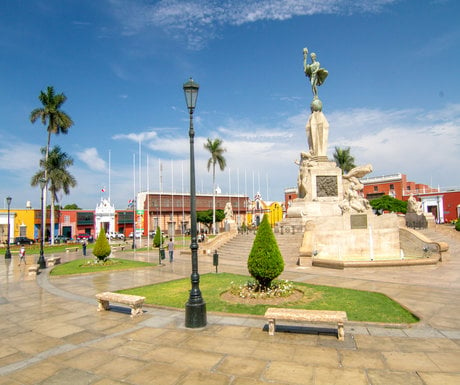 On Sunday mornings, the city holds a flag-raising ceremony in the Plaza de Armas, occasionally accompanied by folk dancing. From Trujillos Plaza de Armas visitors can begin their tour of the old city, and walk to see the colonial architecture on nearby streets.
2. Arequipa
Spanish conquistadors founded Arequipa in 1540. The Spanish built this city with white, volcanic sillar rock native to the area. This architectural feature has earned Arequipa the nickname the white city.
You can visit the plazas Catedral Basilicia to see the religious museum, and then climb the cathedrals bell tower for the best possible view of the plaza. Next to the cathedral youll see the Monasterio de Santa Cantalina, a monastery that has art galleries open to the public, as well as colorful courtyards that have a blend of mestizo and Spanish aesthetics.
At the top of the squares central fountain you will se the statue of a character from Inca legend, called Tuturutu. Tuturutu served as messenger for one of the last Inca kings. He got his name from the sound his horn made when he trumpeted a signal. His spirit is supposed to watch over Arequipa from his perch on top of the fountain.
On Sunday mornings, the city holds a flag-raising ceremony in the Plaza de Armas, occasionally accompanied by folk dancing. From Trujillos Plaza de Armas visitors can begin their tour of the old city, and walk to see the colonial architecture on nearby streets.
2. Arequipa
Spanish conquistadors founded Arequipa in 1540. The Spanish built this city with white, volcanic sillar rock native to the area. This architectural feature has earned Arequipa the nickname the white city.
You can visit the plazas Catedral Basilicia to see the religious museum, and then climb the cathedrals bell tower for the best possible view of the plaza. Next to the cathedral youll see the Monasterio de Santa Cantalina, a monastery that has art galleries open to the public, as well as colorful courtyards that have a blend of mestizo and Spanish aesthetics.
At the top of the squares central fountain you will se the statue of a character from Inca legend, called Tuturutu. Tuturutu served as messenger for one of the last Inca kings. He got his name from the sound his horn made when he trumpeted a signal. His spirit is supposed to watch over Arequipa from his perch on top of the fountain.
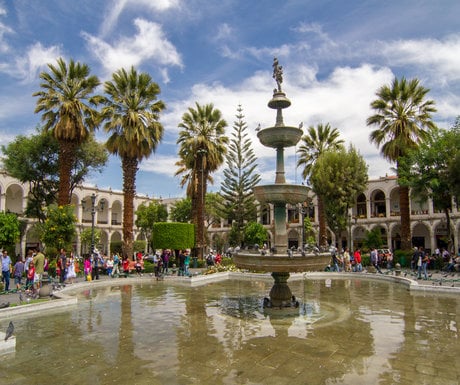 3. Ollantaytambo
Ollantaytambo is high in the mountains, built at 5,879 feet (1,792 m) above sea level. Enormous Inca temples and the peaks of the Andes frame this plaza. Its not easy to take your attention away from the surrounding landscape from the Plaza de Armas you can see the stone terraces of an Inca village on the side of the nearby mountain peek.
3. Ollantaytambo
Ollantaytambo is high in the mountains, built at 5,879 feet (1,792 m) above sea level. Enormous Inca temples and the peaks of the Andes frame this plaza. Its not easy to take your attention away from the surrounding landscape from the Plaza de Armas you can see the stone terraces of an Inca village on the side of the nearby mountain peek.
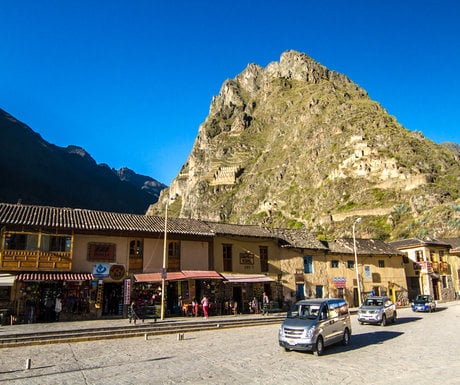 The Inca originally built Ollantaytambo, as well as its streets and its central plaza. Youll see an obligatory Spanish cathedral at the Plaza de Armas, and then you can go for a stroll down the narrow stone streets that lead from the plaza to the courtyards and the solid stone walls that the Inca left behind.
Just a few steps north of the plaza you can visit Museo Cattco, a museum that preserves the ethnography of the surrounding region. All of the displays here are in Spanish, but even if you dont speak the language you can appreciate the ceramics and elaborate weaving on display.
4. Cusco
You can see Cuscos history in its Plaza de Armas. In the middle of the plaza youll see a statue of the Inca ruler Pachacútec. He motions toward Sacsayhuamán, the Inca fortress on the edge of the city. The Spanish adapted this plaza to fit their concept of city planning, although this space initially served as the main square of the original Inca city.
The Cathedral of Cusco is one of the most imposing structures in the city. Spanish colonialists built this cathedral on top of the Inca ruler Viracochas palace. They began building this structure using stone blocks taken from Sacsayhuamán. Construction of the cathedral began in 1559, but the most recent round of renovations was completed in 2002.
The Inca originally built Ollantaytambo, as well as its streets and its central plaza. Youll see an obligatory Spanish cathedral at the Plaza de Armas, and then you can go for a stroll down the narrow stone streets that lead from the plaza to the courtyards and the solid stone walls that the Inca left behind.
Just a few steps north of the plaza you can visit Museo Cattco, a museum that preserves the ethnography of the surrounding region. All of the displays here are in Spanish, but even if you dont speak the language you can appreciate the ceramics and elaborate weaving on display.
4. Cusco
You can see Cuscos history in its Plaza de Armas. In the middle of the plaza youll see a statue of the Inca ruler Pachacútec. He motions toward Sacsayhuamán, the Inca fortress on the edge of the city. The Spanish adapted this plaza to fit their concept of city planning, although this space initially served as the main square of the original Inca city.
The Cathedral of Cusco is one of the most imposing structures in the city. Spanish colonialists built this cathedral on top of the Inca ruler Viracochas palace. They began building this structure using stone blocks taken from Sacsayhuamán. Construction of the cathedral began in 1559, but the most recent round of renovations was completed in 2002.
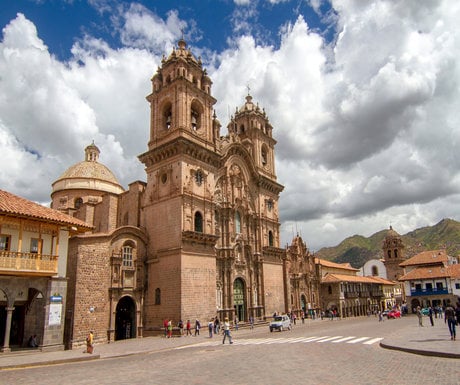 Once youre done admiring the baroque cathedral from the outside, head indoors to see Cuscos most impressive collection of religious art. This cathedral is known for its Cusqueña art collection. The Cusqueña colonial school of art developed from Cusco artists who were trained to paint in a European style. Cusco Cathedral has one of the most famous Cusqueña paintings in Peru. In it, Jesus is seated in front of a distinctly Peruvian dish a roasted guinea pig, served paws and all.
Cusco Cathedral is just one of the three holy sites at this Plaza de Armas. It also has El Cathedral del Tríunfo, which was built in 1539, making it the first church in Cusco. Jesus de la Compañía Cathedral makes a strong visual impression with its green-and-gold domes. The inside of this cathedral is equally arresting, with bright red walls gilded in gold.
5. Huaraz
Huaraz is located in western Peru, in the Ancash Region. An earthquake destroyed much of the city of Huaraz in 1970, including the old colonial cathedral. The cathedral that stands their now was built in 1997. Because of its recent construction, it is one of the few famous Peruvian cathedrals without Baroque architecture.
Once youre done admiring the baroque cathedral from the outside, head indoors to see Cuscos most impressive collection of religious art. This cathedral is known for its Cusqueña art collection. The Cusqueña colonial school of art developed from Cusco artists who were trained to paint in a European style. Cusco Cathedral has one of the most famous Cusqueña paintings in Peru. In it, Jesus is seated in front of a distinctly Peruvian dish a roasted guinea pig, served paws and all.
Cusco Cathedral is just one of the three holy sites at this Plaza de Armas. It also has El Cathedral del Tríunfo, which was built in 1539, making it the first church in Cusco. Jesus de la Compañía Cathedral makes a strong visual impression with its green-and-gold domes. The inside of this cathedral is equally arresting, with bright red walls gilded in gold.
5. Huaraz
Huaraz is located in western Peru, in the Ancash Region. An earthquake destroyed much of the city of Huaraz in 1970, including the old colonial cathedral. The cathedral that stands their now was built in 1997. Because of its recent construction, it is one of the few famous Peruvian cathedrals without Baroque architecture.
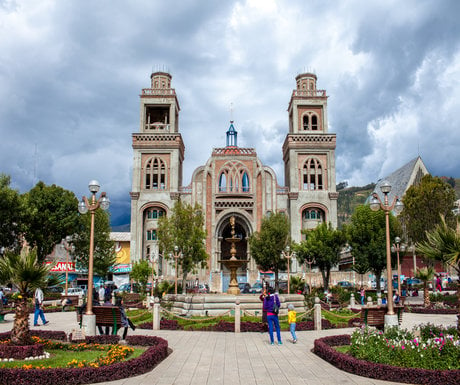 On the corner of the Plaza de Armas, the Archeological Museum of Ancash houses a rich collection of artifacts left behind by the ancient Chimú and Rencuay people. The Rencuay made large stone carvings of rounded figures, some of which are displayed in the museums outdoor lithic garden.
6. Lima
Limas Plaza Mayor marks the original center that conquistador Francisco Pizarro established for the city. In every direction you look youll see important Peruvian landmarks. The Archbishop Palace, the Government Palace, and the Lima Cathedral all show this citys history of Spanish grandeur.
Visitors are welcome to stroll around the cathedral and look at the religious art in the cathedrals museum. This cathedral was completed in 1755, after an earthquake destroyed the original 16th-century cathedral. If youre outside the Governors Palace at noon on a weekday, youll see them change the guard and the official city flags.
On the corner of the Plaza de Armas, the Archeological Museum of Ancash houses a rich collection of artifacts left behind by the ancient Chimú and Rencuay people. The Rencuay made large stone carvings of rounded figures, some of which are displayed in the museums outdoor lithic garden.
6. Lima
Limas Plaza Mayor marks the original center that conquistador Francisco Pizarro established for the city. In every direction you look youll see important Peruvian landmarks. The Archbishop Palace, the Government Palace, and the Lima Cathedral all show this citys history of Spanish grandeur.
Visitors are welcome to stroll around the cathedral and look at the religious art in the cathedrals museum. This cathedral was completed in 1755, after an earthquake destroyed the original 16th-century cathedral. If youre outside the Governors Palace at noon on a weekday, youll see them change the guard and the official city flags.
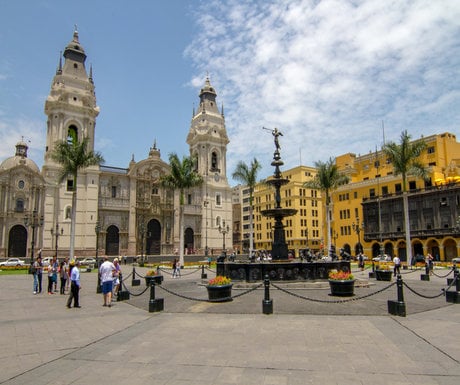 This plaza has a dark history. It used to feature the citys gallows at its center, and during the Spanish Inquisition accused witches were burned at stakes erected in the Plaza Mayor. But you wont see any traces of the violence of the plazas past. The gallows are long gone the plazas central fountain dates back to 1650, and its delicate plumes of water and ornate sculpture echo the plazas stately beauty.
Zach Smith is CEO of Anywhere.
If you would like to be a guest blogger on A Luxury Travel Blog in order to raise your profile, please contact us.
This plaza has a dark history. It used to feature the citys gallows at its center, and during the Spanish Inquisition accused witches were burned at stakes erected in the Plaza Mayor. But you wont see any traces of the violence of the plazas past. The gallows are long gone the plazas central fountain dates back to 1650, and its delicate plumes of water and ornate sculpture echo the plazas stately beauty.
Zach Smith is CEO of Anywhere.
If you would like to be a guest blogger on A Luxury Travel Blog in order to raise your profile, please contact us.Did you enjoy this article?
Receive similar content direct to your inbox.


I have never been considered to visit the Peru, But after reading your post. I have changed my view.Thank you for this such a lovely post.
Beautiful views of Peru. Never been there and now wanna be there for a few weeks as soon as possible.
Those places are beautiful indeed. If you love to travel Peru is definitely worth visiting. Thanks for sharing the pictures.
The Cathedral of Cusco looks amazing. I would love to see it someday. It is incredible how it has stood the test of time. Thanks for a great post.